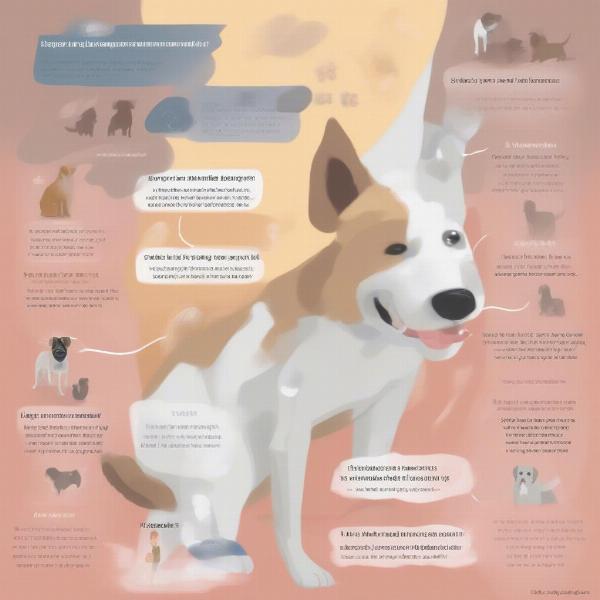Calming drops for dogs are becoming increasingly popular as a way to manage anxiety and stress in our canine companions. Whether your dog suffers from separation anxiety, noise phobias, or general nervousness, calming drops can offer a gentle and effective solution. This guide will explore the different types of calming drops available, their benefits, potential side effects, and how to choose the best option for your furry friend.
Understanding Canine Anxiety and the Role of Calming Drops
Just like humans, dogs can experience anxiety in various situations. From thunderstorms and fireworks to car rides and vet visits, many triggers can cause stress in dogs. Anxiety manifests in different ways, including excessive barking, panting, pacing, destructive behavior, and even aggression. Calming drops work by interacting with the dog’s nervous system to promote relaxation and reduce anxiety symptoms. They can be a valuable tool in helping your dog cope with stressful situations and improve their overall well-being.
Types of Calming Drops for Dogs
There are several types of calming drops available, each with its unique ingredients and mechanism of action:
- Pheromone-based drops: These drops mimic natural dog-appeasing pheromones, which have a calming effect. They are synthetic versions of the pheromones mother dogs release to comfort their puppies.
- Hemp-based drops: Containing CBD or other hemp extracts, these drops are believed to interact with the endocannabinoid system to promote relaxation and reduce anxiety.
- Herbal and natural remedies: These drops utilize ingredients like chamomile, lavender, valerian root, and L-theanine, known for their calming properties.
- Melatonin-based drops: Melatonin is a hormone that regulates sleep-wake cycles. Melatonin drops can be helpful for dogs with anxiety related to sleep disturbances or travel.
Choosing the Right Calming Drops for Your Dog
Selecting the appropriate calming drops requires careful consideration of your dog’s individual needs, age, size, and the specific type of anxiety they experience. Consulting with your veterinarian is crucial to determine the best option and dosage for your dog. They can assess your dog’s overall health and rule out any underlying medical conditions that may be contributing to their anxiety.
Administering Calming Drops Effectively
Follow the manufacturer’s instructions carefully when administering calming drops. Most drops are given orally, either directly into the dog’s mouth or mixed with food or water. The onset of effects can vary depending on the type of drops used, ranging from a few minutes to an hour. It’s essential to observe your dog closely for any adverse reactions and consult your veterinarian if you have any concerns.
Potential Side Effects and Precautions
While calming drops are generally safe, some dogs may experience mild side effects such as drowsiness, lethargy, or changes in appetite. It’s crucial to start with the lowest recommended dose and gradually increase it as needed, under the guidance of your veterinarian. Avoid using calming drops in pregnant or nursing dogs, and always consult with your veterinarian before using them in conjunction with other medications.
Calming Drops vs. Other Anxiety Management Techniques
 Comparison between calming drops, behavioral training and environmental modification
Comparison between calming drops, behavioral training and environmental modification
Calming drops can be used as a standalone solution or in conjunction with other anxiety management techniques, such as behavior modification training, environmental enrichment, and regular exercise. Addressing the underlying causes of anxiety through training and creating a calm and predictable environment can significantly enhance the effectiveness of calming drops.
Conclusion
Calming drops can be a valuable tool in helping your dog manage anxiety and stress, improving their overall quality of life. By understanding the different types of calming drops, consulting with your veterinarian, and implementing a comprehensive anxiety management plan, you can provide your furry friend with the support they need to thrive.
FAQ
- Are calming drops safe for all dogs? While generally safe, it’s crucial to consult with your veterinarian to determine the appropriate type and dosage for your dog.
- How long do the effects of calming drops last? The duration of effects varies depending on the type of drops and individual dog, typically lasting several hours.
- Can I use calming drops for long-term anxiety management? Discuss long-term use with your veterinarian, as they can recommend the best approach for your dog’s specific needs.
- What should I do if my dog experiences side effects? Contact your veterinarian immediately if your dog shows any adverse reactions.
- Can calming drops be used with other medications? Consult with your veterinarian before combining calming drops with other medications.
- Are there any natural alternatives to calming drops? Yes, options like pheromone diffusers, calming music, and anxiety vests can be helpful.
- How can I find the best calming drops for my dog? Your veterinarian can guide you in selecting the most suitable option based on your dog’s individual needs and anxiety type.
ILM Dog is a leading online resource dedicated to providing dog owners with expert advice and information on all aspects of dog care, from breed selection and health to training and nutrition. We are committed to helping you provide the best possible care for your furry companion. For more information, visit ILM Dog or contact us at [email protected] or +44 20-3965-8624.